This looks really nice. I have a Convoy M1 I’d love to mod an XHP50.2 into, but I’m wondering if a stable moon mode is possible using this kind of current regulation, or if we’re stuck with a low mode that blinds the eyes at night. If loneoceans or anyone else can demonstrate that a stable moon mode is possible, I’d definitely be interested.
Any news about this driver ?
Subbed.
I need this driver for Astrolux SS with Nichia 144.
NEEED !!! ![]()
Hope to see it available somewhere soon (EU).
Loneoceans hasn’t been active for a while or responded to emails so I designed a 17mm version of the original GXB20 boost schematic and adapted it for my own purposes (ATtiny1634 and OTSM). I just got the PCBs this morning but don’t have time to build and develop the firmware before I drop of the radar for 2 months vacation starting Friday. If nothing has happened with the GXB17 once I’m back in November I’ll continue, but by then there will probably be other alternatives available.
I don’t have enough hardware experience to do that myself, but if I had what I needed to build a board, I might be able to work on firmware while you’re gone. Then again, chances are good that I wouldn’t have time, either way.
I’ve got full 1634 firmware functionality for “normal” drivers (AMC7134 & FET), so I don’t need to implement much more than digipot control and a different mode level system. It’s just that other things have higher priority before I leave.
Oh I didn’t think of that, but it makes sense in hindsight. I took a look at some of your other mods and I see what you mean.
Were you able to fit it into 17mm without changing the BOM at all?
No changes to the actual boost circuit except an additional resistor (thanks to a suggestion from user Schoki). I use a different digipot though, and then some additions for OTSM. I didn’t fit it in two layers though, I have KiCad and can design four layer boards.
Too bad loneoceans didn’t share his GXB17 design before disappearing. He got it done in two layers but he did change some things from the original GXB20 schematics that I have used. I would have preferred to have modified his design for my purposes rather than making a new board, but now I have it and just have to test it.
Can I use this on a Solarforce Gladiator P60 drop in? I want to use four 18650 but it's hard to find a driver that could handle 18 volts.
Greetings everyone!
It's been a long while (half a year or so?) since I've been back to BLF, and I hope everyone is having a good start to 2018! Also wishing everyone a very happy lunar new year! I'm sure I've missed out a lot (any one care to update me if there's been any new updates to driver / light developments?), but have been really busy with things. Well over the past two weeks or so I had some time and sorted out some of my old project documents on the GXB17 so I thought I'll share an update!
TLDR; First, I finally put a GXB17 into a flashlight, actually back in 2017 but didn't have a chance to show it here. I placed a GXB17 into a 'shorty' Convoy S2+ powered by a single 18350 battery and have been running it with a XHP50.2 LED since with about 2000 lumens! Second, I was motivated enough to work on a new project and it's coming together... hint - you'll have to read below to find out more!
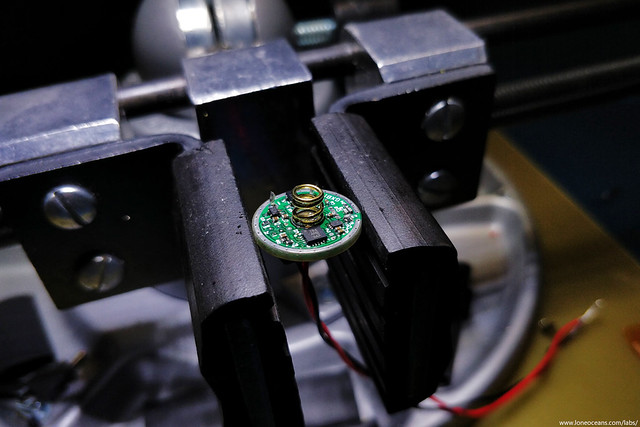
---
GXB17 Convoy S2+ 18350 Build
The main reason why I made the GXB17 was to be able to fit the driver into common flashlights, and also because I realized how nice the Convoy hosts were (apologies for my 'noobness' but these GXB projects were really my first foray into the flashlight world). I also found out that they came with lots of customization options, so I thought it'll be fun and pretty ridiculous to make a 18350 flashlight put out 2000 lumens.
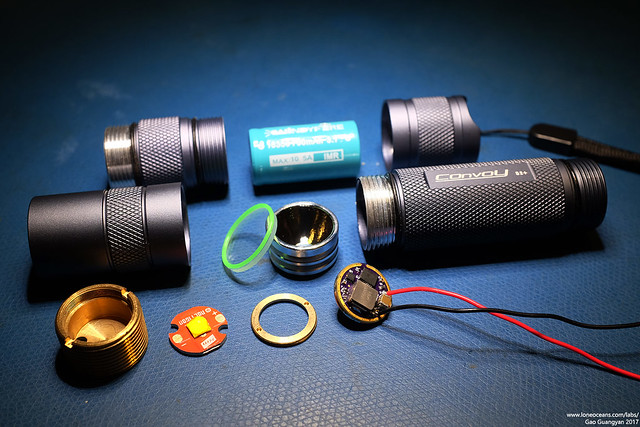
First up, I ordered a S2+ host and a short body tube and a 18350 WindyFire (read somewhere this was one of the best hi-drain small batteries), and made sure everything fit. I also wanted to try out the XHP50B LEDs which were starting to hit the market, so I reflowed one I got from Mouser onto a Noctigon MCPCB.
Once I made sure everything it, I put it all together and it came together without much fuss.
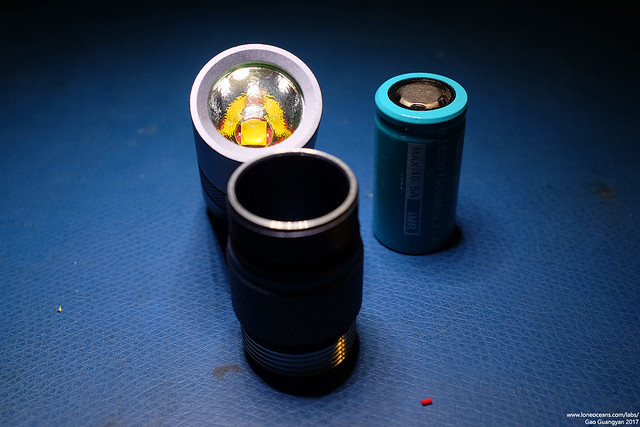
It's quite funny to see the short Convoy S2+ with such a big LED in the midde of the reflector, but it all fits well!
I turned it on and... it works great! The flashlight at full power is definitely useless, mostly because (1) it gets up to my 70C temp-limit very quickly, and (2) the run time at full power (keeping it under a cold tap or something) is something on the order of like less than 10 minutes, though expected from a 700mAh cell! However, it's really pretty hilarious in real life. ![]()
I don't really have many flashlights to compare them with, but I thought I'll try to show some comparisons.
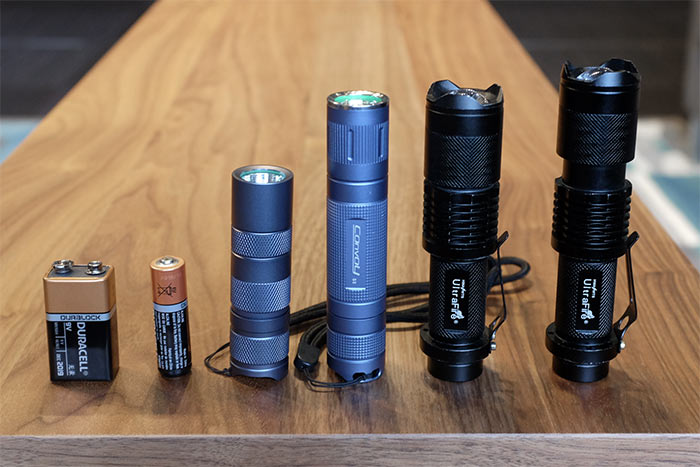
First, here's a comparison photo of my GXB17 S2+ 18350 withj a XHP50.2 J4 LED, followed by a regular Convoy S3 with 2.1A drive (6x 7135) and XML2 T6 LED, then the following two are the cheapo SK98 zoomy lights fitted with a GXB20 and a XHP50A G2 90CRI LED.
Second, I did a completely non-scientific test using my phone's 'LightMeter' app, to get a ball-park estimate of brightness. The phone was placed on the middle of my room, and the flashlights were turned on and placed at the same area of the room, pointing directly upwards. Then I used the app to get a Lux value based on the brightness of the ceiling. I found that this was fairly consistent because my room is (very) small, and moving the light around a little didn't affect the readings much at all. The two zoomy lights were zoomed all the way out.
- Convoy S3 at 2.1A drive on Cree XML2 (750 datasheet lumens) - 50 Lux
- SK98 with GXB20 and Cree XHP50A G2 CRI 90 LED (1700 datasheet lumens) - 102 Lux
- Convoy S2+ Shorty with Cree XHP50B J4 CRI 70 LED (~2000 datasheet lumens) - 137 Lux
These readings were very consistent (tested the next day with practically the same values). Again this is not scientific, but I hope it gives some sort of numerical value for a relative comparison. Clearly the J4-class LED is brighter than the G2-class LED, at the cost of poorer CRI. Also, it's clear that the optics for the SK98 are more inefficient than the reflector of the S2+, so I think the numbers sort of make sense!
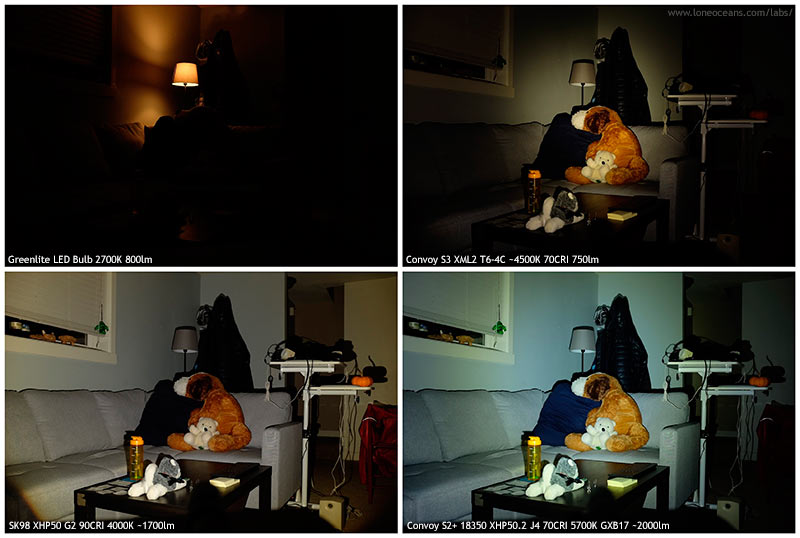
Finally, beam comparisons! I compared those 3 flashlights together with how a regular 800 lumen bulb looks like. All photos were taken with a fixed setting (ISO, Aperture, Shutter Speed, White Balance). Here we can clearly see how the 90CRI Cree does have a much nicer colour rendition than the 70CRI Cree. Also obvious is the illumination characteristic of each flashlight, as well as the LED (greenish/yellow spill of the XHP50.2, but really looks better in real life). I know these photos look 'dim' but I had them underexposed to prevent blown highlights and to really see the difference in brightness between the lights!

Finally, just in case people want more details, schematics, etc .... no worries!
I also spent a bit of time writing up a page about the GXB17 project here! http://loneoceans.com/labs/gxb17/ Feel free to check it out and I hope it will be at least interesting to people who want to make their own too!
---
What's Next?
Looking back at my GXB17 project and putting things together in a page was pretty fun, and it gave me a lot of motivation and inspiration!
The GXB17 projected resulted in a small 18350 flashlight which was frankly quite ridiculous and not at all practical in real life, but I really enjoyed the engineering!
However, there's a problem!
About a week and half ago, I was alerted from a friend (when I casually mentioned my GXB projects allowing 2000 lumens of light from a single battery) that some new ~4000 lumen flashlights were on the market (single cell). So it turns out there now exists consumer lights like the Imalent DN70 and Trunight TC20 which put out a whopping 3800 lumens all from a single cell, albeit from a larger 26650 battery.
This got me thinking, and I wound up spending a good lunchtime thinking that maybe I should try to make an even more ridiculous flashlight, again keeping with the 18650 or 18350 size, and to see how bright I can actually make the flashlight to be.
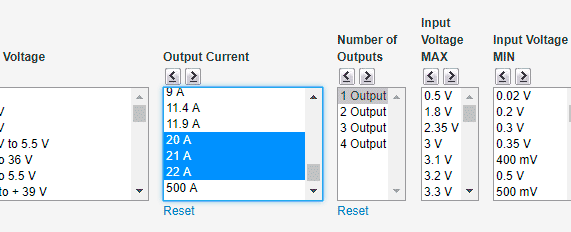
So I did what EE hobbyists do on their free time and browsed Mouser electronics and Digikey, doing parametric search for boost converters and... I saw something new... (the 11.9A one was the previous for-new-design top IC which is the TSP61088 used in the GXB20/GXB17 drivers)....
I quickly whipped out something literally in an afternoon and sent for a PCB to be made, and just got it in time.
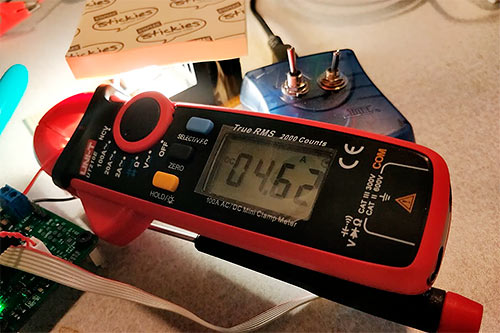
Let's just say I'm currently maxed out on my bench supply ![]() . The current measurement goes to a XHP50 in 6V configuration. For comparision, I previously tested my GXB20 to around 3.25A or so... More to come soon but I probably shouldn't hijack my own thread (will start another one later).
. The current measurement goes to a XHP50 in 6V configuration. For comparision, I previously tested my GXB20 to around 3.25A or so... More to come soon but I probably shouldn't hijack my own thread (will start another one later).
Cheers
This driver of your would be ideal for the P60 crowd. Copper pills exist along with potting. Long have a few wanted XHP35,50 and 70’s in a single cell configuration like the P60 dropin’s. As a dropin it could be in a 18350 mini, 18650 regular or in a newer 20700/21700 host. For the last couple of weeks I’ve been emailing back and forth to a manufacturer about building a 20700/21700 P60 style host. This driver would go nicely with it.
Welcome back. ![]()
We’ve gotten a new thread for driver developments:
You can read there about a MP3431 based boost driver developed by Schoki with a help from Lexel.
Also, Mike C tried to build GXB17, I’m not sure about the result.
Oh dear haha I guess I should have came back to see this a little earlier... because my little new project is basically done ![]() , and it also uses the MP3431/3429 as linked above which I discovered just recently browsing Mouser (see previous post), and has some simple new features. So far it's been doing great with 8A input (battery side). However, a lot more things to write! I'll try to write a proper post this weekend and catch up on the news!
, and it also uses the MP3431/3429 as linked above which I discovered just recently browsing Mouser (see previous post), and has some simple new features. So far it's been doing great with 8A input (battery side). However, a lot more things to write! I'll try to write a proper post this weekend and catch up on the news!
No, I didn’t try. I got the bare PCB boards from loneoceans, and then designed my own based on them, but I never actually built one. I had some questions and asked loneoceans by mail and PM, but he didn’t bother answering.
A short time after Schoki and Jensen567 showed interest in making a similar driver, but fully open to BLF comunity with source files and BLF developed firmware. Because Schoki’s driver is BLF developed and supported I just decided to wait on that instead of spending time developing a board only a single non responsive person could answer questions about.
How do you control the current output of the MP3431? Like the GXB17 with a digipot? Or differently?
Hey Mike C, many apologies! I hope I didn't come across as trying to ignore you. I receive something like 5 to 10 project related emails (mostly on my other lab projects stuff) on a daily basis and it's impossible for me to get through and reply to all of them despite my best efforts. That said, I checked my PM and it appears I replied to the PMs you messaged me with questions? And I can't seem to find any emails from you either (though it appears you've only sent me a single email if I'm not mistaken!). Either way, many apologies. As for Schoki's driver, sounds fantastic! It' great to have a community developed driver! I'll go read up on it later this weekend.
Schoki, how's the boost driver you're working on going? Actually back when I was making my GXB20 driver I bought a H1-A driver since a lot of people were talking about it. It took something like 2 months to arrive (maybe lost in the mail or something?) but I tested it out and it worked ok. I did a very quick inspection and I liked how it did the control, so I used essentially the same idea for this new MP3429/31 driver. The digipot works great but it's fairly expensive ($2 or so) and I found that the low-wiper resistances are very inconsistent part to part (within datasheet spec but too inconsistent for consistent moonlight mode).
I did a quick lash up and found that the H1-A control works fine, with fewer components, so I've adopted it with some modifications. However, the design does have a few drawbacks so it needs a little tinkering with. Essentially the control is simple, taking a low-side current shunt reading and comparing it with a low voltage DC value generated using microcontroller PWM and scaled accordingly using a low input off-set Op Amp such as the Maxim MX96xx series, which is then scaled appropriately to the feedback pin of the MP34xx. Other than requiring a decent op-amp, this scheme seems to work well with appropriate adjustments. I've also since tested some other schemes with similar ideas essentially using other different current amplifiers methods and they all work great too, so it's just a matter of optimization for the widest range of brightness levels with the cheapest and fewest components. In fact, I've already sent out boards for a Rev B GXB17 with a litte more power, and a bunch of other features but still using the TPS controller since I've got that nailed down. That said, there are already a lot of physical limitations when running a standard flashlight at >20+W from a single cell, so any further gains I get from this new IC are probably not very sensible anyway, but still very fun! ![]()
Ahh, my bad. I sent emails, not PM. Oh well, doesn’t matter anymore.
I pretty much did the same thing with my driver, now I wait until testing is successful, and then the driver should be ready to go, but you never know…
I’ll wait until I release any details though. Everything will be available when I’m sure it works and I made a thread.
Hi all! The GXB17 has been superceded with the newer GXB172 which has much better performance.
Please see here for more information: https://budgetlightforum.com/t/-/50015. As a result, work on the GXB17 will be discontinued. Thanks so much to everyone who has supported this project, provided criticism and suggestions, and followed it from the start to the end! ![]()
Amazing effort on the black magic loneoceans. ![]()